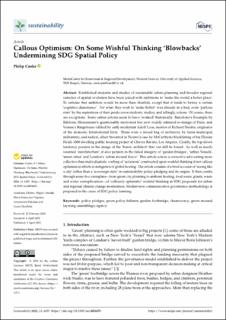| dc.description.abstract | Established students and studies of sustainable urban planning and broader regional varieties of spatial evolution have been seized with ambitions to ‘make the world a better place’. To criticise that ambition would be more than churlish, except that it tends to betray a certain ‘cognitive dissonance’. For what they wish to ‘make better’ was already in a bad, even ‘parlous state’ by the aspirations of their predecessor students, studies, and tellingly, actions. Of course, there are exceptions. Some urban actions seem to have ‘worked’ historically. Barcelona’s Eixample by Ildefons, Haussmann’s questionably motivated but now widely admired re-design of Paris, and Vienna’s Ringstrasse vilified by early modernist Adolf Loos, mentor of Richard Neutra, originator of the domestic International Style. These were a mixed bag of architects, by turns municipal, militaristic, and radical, albeit thwarted in Neutra’s case by McCarthyite blacklisting of his Elysian Fields 3300 dwelling public housing project at Chavez Ravine, Los Angeles. Clearly, the top-down tendency persists in the image of the ‘heroic architect’ that can still be found. As well as much-vaunted ‘starchitecture’, it also persists in the failed imagery of ‘garden bridges’, ‘urban Vessels’, ‘smart cities’ and London’s ‘urban mound fiasco’. This article acts as a corrective advocating more collective than individualistic crafting of ‘solutions’ constructed upon wishful thinking if not callous optimism in efforts at mitigation of global heating. The article consists of a brief account of ‘seeing like a city’ rather than a ‘sovereign state’ in sustainability policy-pledging and its origins. It then combs through some five exemplars—from green city planning to ambient heating, food waste, plastic waste and water eutrophication—of ‘callously optimistic’ wishful thinking in SDG proposals for urban and regional climate change moderation. Modest new communicative governance methodology is proposed in the cause of SDG policy learning.
Keywords: policy pledges; green policy failures; garden footbridge; chumocracy; green mound; layering; assemblage; agency | en_US |

